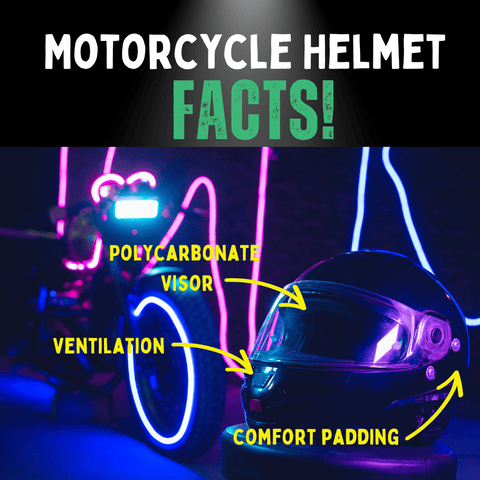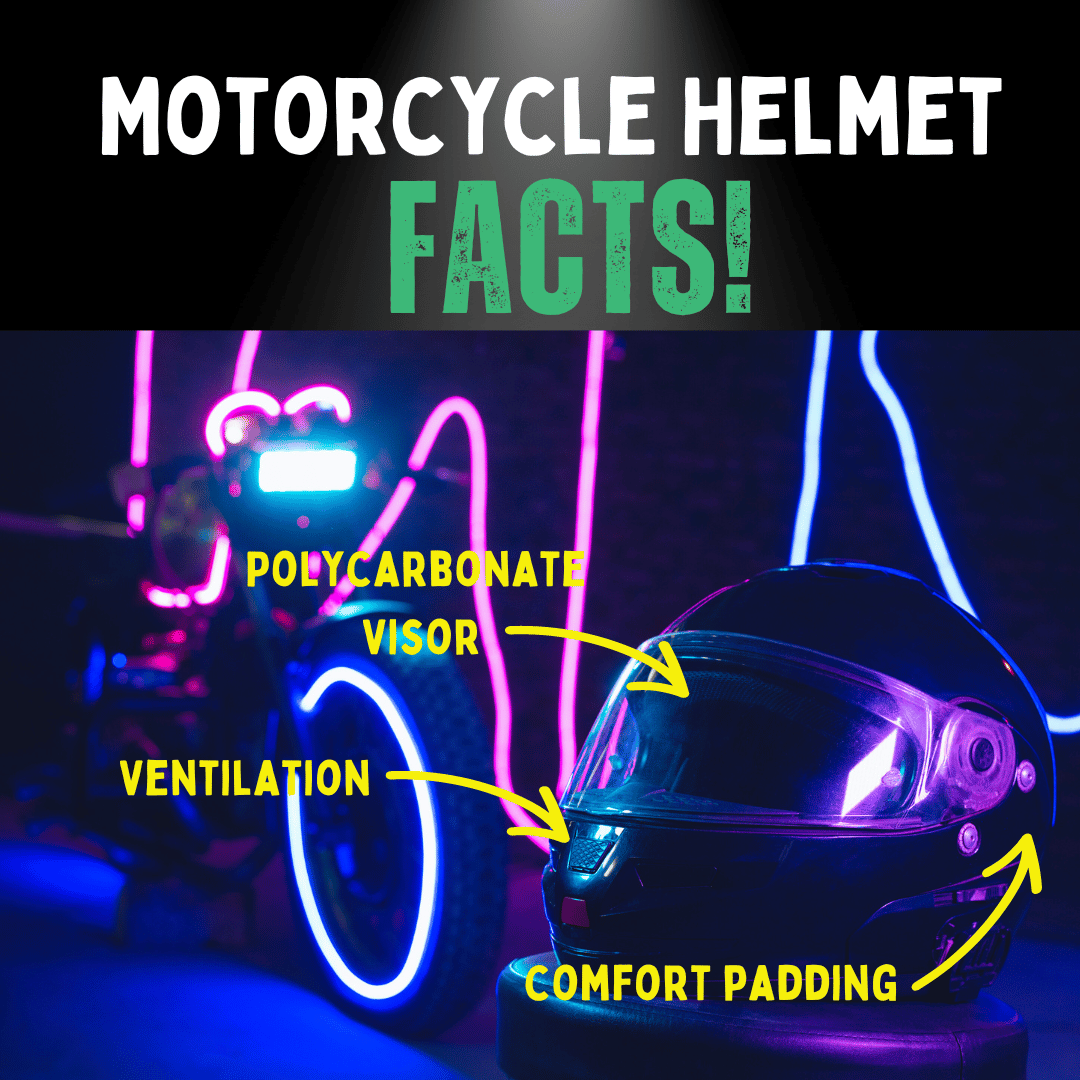
Updated: 27.05.25
Motorcycle helmets reduce serious head injury risk by up to 70% and fatal injuries by 65%, critical for rider safety. Even low-speed crashes can cause harm, but a quality helmet significantly lowers these risks. This guide covers 10 key facts to choose the right motorcycle helmet.
Key Motorcycle Helmet Fact
A well-fitted helmet should be snug around the forehead without pressure points. Test fit by moving it side-to-side and up-and-down; it should stay secure without discomfort.
1. Motorcycle Safety Basics
Helmets are vital, but safe riding skills are equally important. Regular training enhances safety for all riders. 25 Game-Changing Motorcycle Hacks.
2. Helmet Safety Standards
Certified helmets (DOT, Snell, ECE 22.06) reduce head injury risk by nearly 70% and fatal injuries by 65%, crucial since 80% of UK motorcyclist fatalities involve head injuries. The foam liner absorbs impact, but degrades over time due to UV exposure and oils, requiring replacement every 5 years.
| Standard | Region | Description |
|---|---|---|
| DOT | U.S. | Baseline safety standard. |
| Snell | U.S. | Advanced testing for superior protection. |
| ECE 22.06 | UK/Europe | Mandatory UK standard. |
3. Types of Motorcycle Helmets
While bike helmets suit cycling and skateboarding, motorcycle helmets offer enhanced protection with visors and chin bars. Key types include:
| Helmet Type | Description | Best For |
|---|---|---|
| Full Face | Full coverage, maximum protection. | Road safety. |
| Modular | Flip-up design for versatility. | Flexible use. |
| Dual-Sport | On/off-road compatibility. | Adventure riding. |
| Off-Road | High impact resistance. | Motocross. |
Why Are Off-Road Helmets Different?
4. Helmet Anatomy
- Outer Shell: Disperses impact force.
- Impact-Absorbing Liner: Reduces energy to the skull.
- Padded Comfort Layer: Enhances fit and comfort.
- Chin Strap: Secures helmet during crashes.
5. 2025 Helmet Innovations
- Advanced Materials: Carbon fiber and dual-density foam improve durability.
- Rotational Protection: Reduces brain injury risks.
- Smart Features: Bluetooth, GPS, and AR displays enhance functionality.
- Airbag Systems: Add extra impact protection.
- Enhanced Visors: Anti-fog and UV-protective coatings.
Motorcycle Safety: A Beginner’s Guide
6. Finding the Perfect Fit
Measure head circumference and use sizing charts. Ensure a snug fit without discomfort. Get the Right Motorcycle Helmet Fit.
7. Helmet Maintenance
Clean with manufacturer-approved agents and inspect regularly for damage to maintain effectiveness. How to Clean Your Dirt Bike Helmet.
8. Visors and Ventilation
Choose helmets with anti-fog, UV-protective visors and effective ventilation for safety and comfort. Why Do Dirt Bike Helmets Have Visors?.
9. Helmet Lifespan and Accessories
Replace helmets every 5 years due to foam degradation from UV light and oils. Add accessories like Bluetooth or cameras from RiiRoo’s motorcycle accessories, ensuring they don’t compromise safety. 8 Steps to Upgrade Your Motorcycle Visor.
10. Avoiding Counterfeit Helmets
Buy from reputable dealers, verify certifications, and avoid suspiciously cheap helmets to ensure safety.
11. Motorcycle Security
Use locks and GPS trackers to protect your bike. How to Protect a Motorcycle From Theft.
12. History of Helmets
Helmets trace back to ancient civilizations, using metal and leather for protection. Modern motorcycle helmets evolved in the 20th century with advanced materials like carbon fiber and foam liners, enhancing safety and comfort.
Helmet Brand Comparison
| Brand | Model | SHARP Rating | Features |
|---|---|---|---|
| Airoh | Valor | 5 stars | High safety, good ventilation |
| Shoei | GT-Air 3 | 4–5 stars | Sunshield, ventilation |
| HJC | C10 | 3–4 stars | Budget-friendly, ECE 22.06 |
Conclusion
Choose a certified, well-fitted helmet from brands like Airoh or Shoei to reduce injury risks by up to 70%. Regular maintenance and proper fit ensure safe, enjoyable rides.
Frequently Asked Questions
Why is a snug-fitting motorcycle helmet important?
A snug helmet stays secure during crashes, preventing rotation and maximizing protection.
How often should I replace my motorcycle helmet?
Replace every 5 years from purchase or 7 years from production due to foam degradation from UV light and oils.
What mistakes should I avoid when buying a helmet?
Avoid incorrect sizing, uncertified helmets, or prioritizing style over safety.
Are pricier helmets safer?
Not always, but they often include advanced materials and features for enhanced safety.
Why are helmets crucial for low-speed crashes?
Even low-speed crashes can cause serious head injuries; helmets reduce this risk by absorbing and distributing impact force.
How can I afford a quality helmet on a budget?
Choose certified budget options like HJC, buy from reputable dealers, and maintain properly to extend lifespan.
Additional Resources
- Motorcycle Safety Guide
- Cleaning Your Dirt Bike Helmet
- Protecting Your Motorcycle From Theft
- Motorcycle Accessories
Get in Touch 🚀
Loved our guide on Motorcycle Helmets? Visit RiiRoo.com for more tips!
Questions about ride-on toys or helmets? Use our Live Chat for expert advice!













Share:
8 Proven Steps to CLEAN Your Motorcycle Engine Like a PRO
Struggling with Pit Bike Backfires? Here's Your FIX!